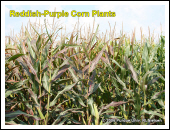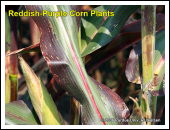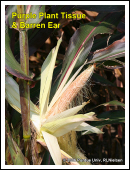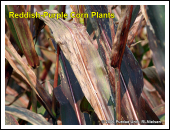September 2009
URL: http://www.kingcorn.org/news/timeless/PurpleCorn2.html
Reddish-Purple Corn Plants Late in the Season
R.L. (Bob) Nielsen
Agronomy Dept., Purdue Univ.
West Lafayette, IN 47907-2054
Email address: rnielsen
at purdue.edu
![]() eems like every August, about mid-month or later, some curious farmer calls his local agronomist to complain that he is puzzled over the preponderance of puzzling purplish plants proliferating in his production paddocks. Unless you are an Ohio State or a Nebraska football fan, the sudden appearance of reddish plants in your fields late in the season can be a bit disconcerting.
eems like every August, about mid-month or later, some curious farmer calls his local agronomist to complain that he is puzzled over the preponderance of puzzling purplish plants proliferating in his production paddocks. Unless you are an Ohio State or a Nebraska football fan, the sudden appearance of reddish plants in your fields late in the season can be a bit disconcerting.
As I've indicated in an article about early-season purpling in young corn, purpling of corn plant tissue results from the formation of a reddish-purple anthocyanin pigments that occur in the form of water-soluble cyanidin glucosides or pelargonidin glucosides (Kim, 1998). A hybrid’s genetic makeup greatly determines whether corn plants are able to produce anthocyanin. A hybrid may have none, one, or many genes that can trigger production of anthocyanin. Purpling can also appear in the silks, anthers and even coleoptile tips of a corn plant.
Most researchers agree that these pigments develop early in the season in young plants in direct response to a number of stresses that limit the plants’ ability to fully utilize the photosynthates produced during the day. These stresses include cool night temperatures, root restrictions, and water stress (both waterlogged and droughty conditions). Since the anthocyanin occurs in the form of a sugar-containing glucoside, the availability of high concentrations of sugar in the leaves (photosynthesis during bright, sunny days) further encourages the pigment formation. If fields are stressed by other factors such as soil compaction, herbicide injury, disease damage, or insect injury, the purpling becomes even more pronounced.
Late in the season, the explanation for the production of these reddish-purple pigments is fundamentally the same (an abundance of photosynthetic sugars in the stalk and leaves) though the fundamental cause of the sugar buildup is different. Late in the season, stalks and leaves will turn reddish-purple when kernel set on the developing ear is minimal or non-existent (i.e., barren ears). The presence of a partially or totally barren ear represents a tremendous reduction in the consumption of photosynthates being generated by that great, big solar-powered photosynthetic factory we call a corn field. Thus, puzzling purplish pigmented plants can develop in response to poor pollination success, severe kernel abortion, severe silk-balling, or arrested ears of various shapes and sizes.
While purpling is not the cause of the problem, it's existence certainly represents the proverbial "red flag" that signals serious problems with ear size or kernel set.
Related References
Dixon, Richard A. and Nancy L. Paiva. 1995. Stress-lnduced Phenylpropanoid Metabolism. The Plant Cell 7:1085-1097. American Society of Plant Physiologists. [On-Line]. Available at http://www.plantcell.org/cgi/reprint/7/7/1085. [URL accessed Sep 2009].
Kim, Jae Hak. 1998. Maize Anthocyanin Pathway. Pennsylvania State Univ. [On-Line]. Available at http://scripts.cac.psu.edu/courses/plphy/plphy597_hef1/mpath.html. [URL accessed Sep 2009]. Editorial note: This link is for biochemistry fans!
Nielsen, R.L. (Bob). 2008. Kernel Set Scuttlebutt. Corny News Network, Purdue Univ. [online]. http://www.kingcorn.org/news/timeless/KernelSet.html [URL accessed Sep 2009].
Nielsen, R.L. (Bob). 2009. Blunt Ear Syndrome....Again. Corny News Network, Purdue Univ. [online]. http://www.kingcorn.org/news/timeless/BluntEars.html [URL accessed Sep 2009].
Nielsen, R.L. (Bob). 2009. Prevalent Purple Plants Possibly Puzzle Producers. Corny News Network, Purdue Univ. [online]. http://www.kingcorn.org/news/timeless/PurpleCorn.html [URL accessed Sep 2009].






